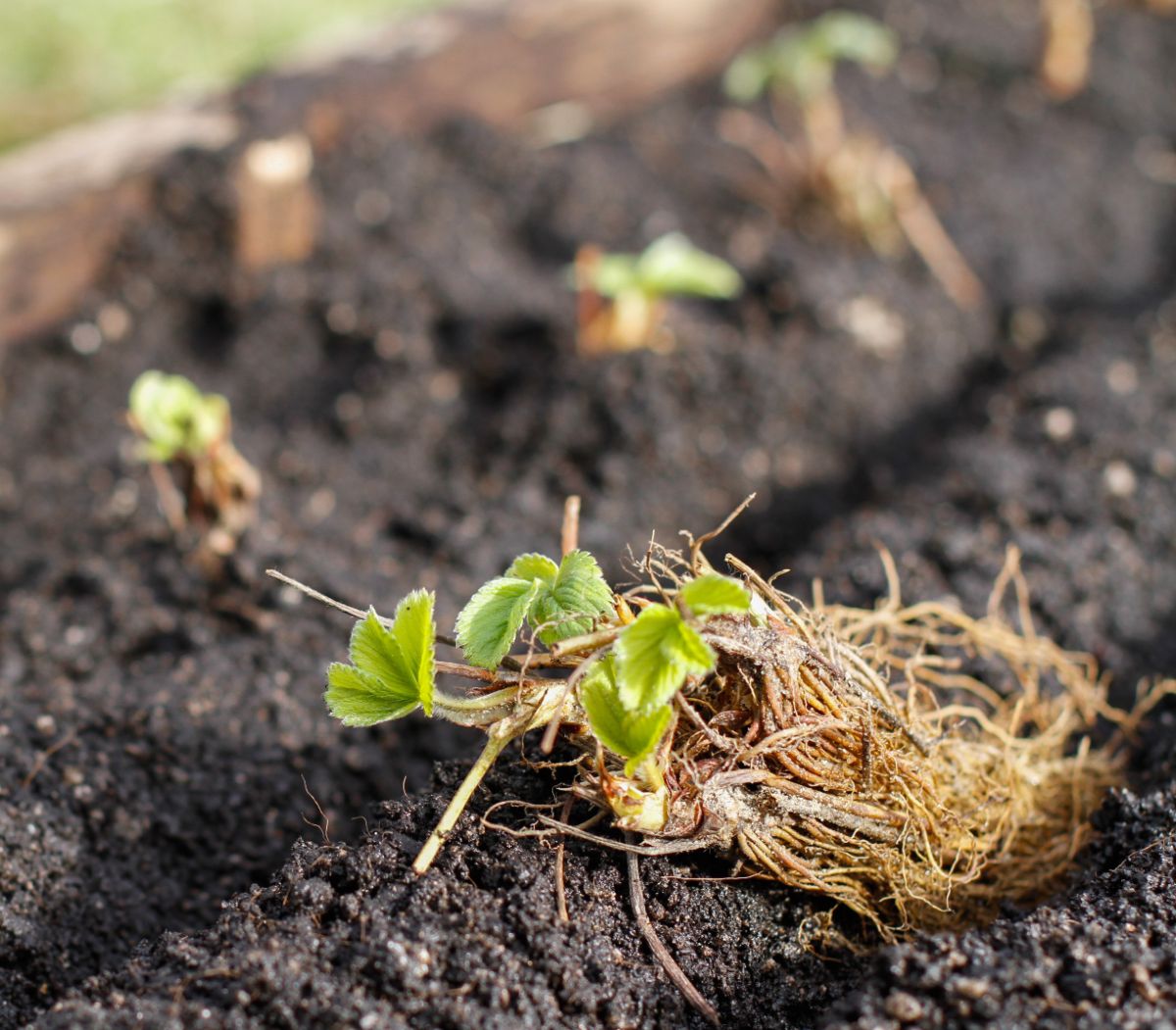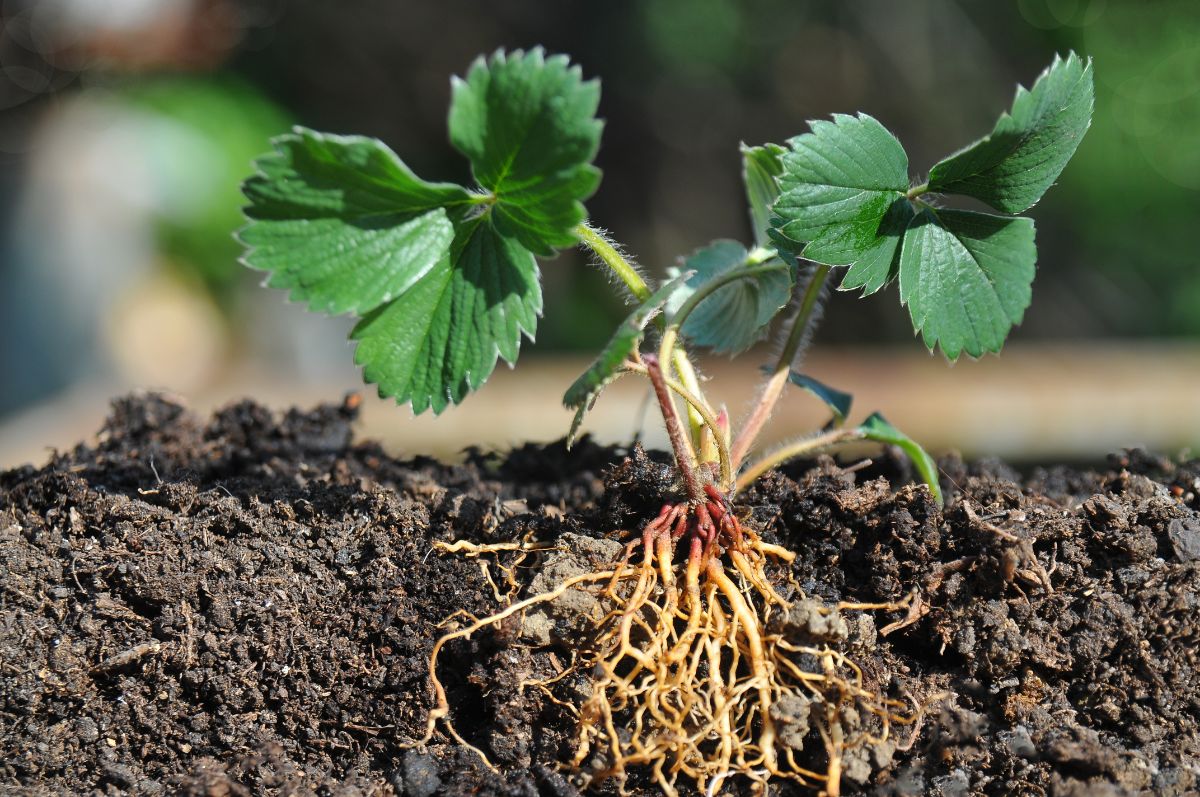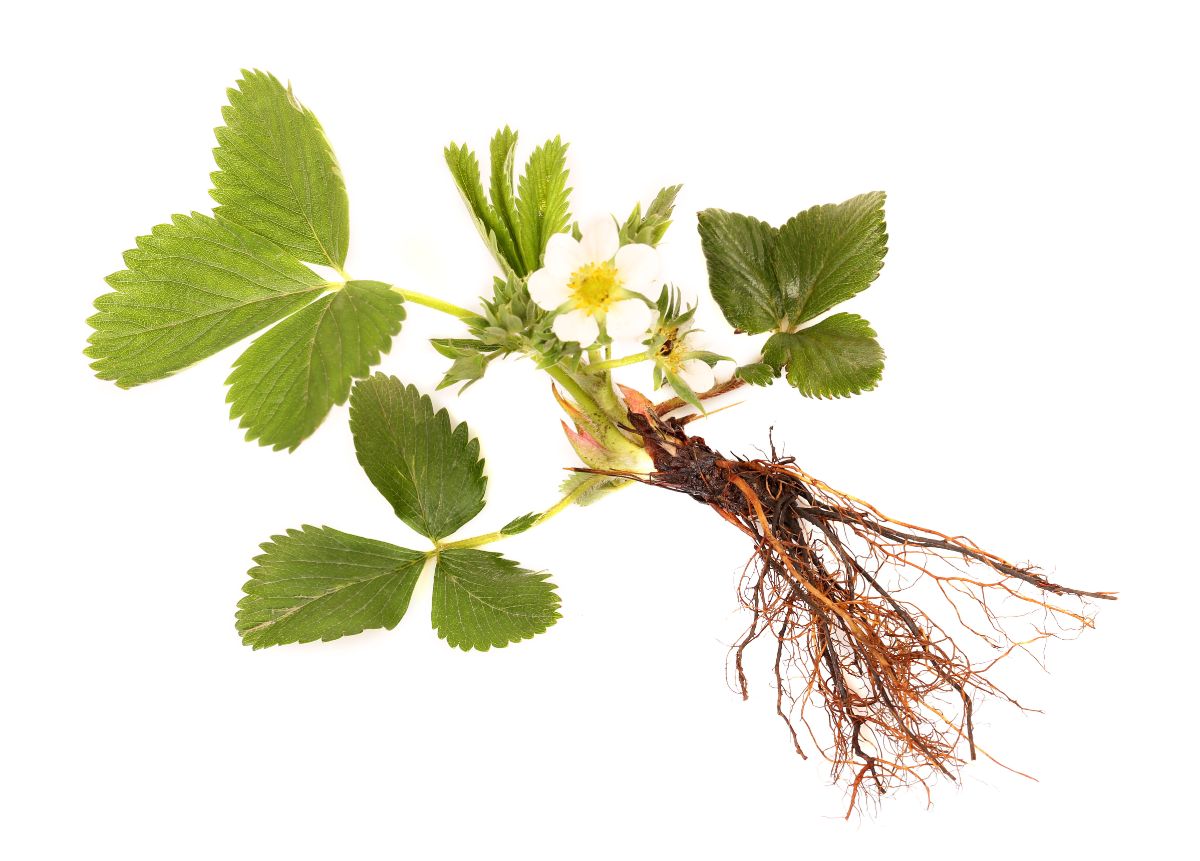Bare-root strawberry plants take a little more work than strawberry plants growing in pots, but they are a great way to get the variety you are looking for at a price that won’t strain your budget so you can grow all the strawberries you want.
Jump to:
- Two Reasons to Choose Bare-Root Strawberries
- Recommended Bare-Root Plants to Buy and Plant
- Two Things You Need to Know About Planting Bare-Root Strawberries
- Before You Plant Your Bare-Root Strawberries, Be Sure to Take Time Out for This.
- Getting Ready to Plant Your Bare-Root Strawberries
- Planting Technique for Your Bare-Root Strawberry Plants
Two Reasons to Choose Bare-Root Strawberries

Bare-root strawberries are the most economical way to plant a new strawberry patch. You can find companies that offer as many as 25 plants of almost any variety for as little as $15. That’s enough strawberries to plant a bed that is 10 feet long and about 30 to 36 inches wide, big enough for the average family without producing more strawberries than you know what to do with.
Another advantage of bare-root strawberries is that they are often the only way to get the exact cultivar of strawberries you want. Usually, your local nursery will stock only two or three varieties of strawberries. They aren’t likely to have the exact cultivar you want.
Maybe you are looking for a sturdy plant that bears firm berries with lots of flavor like the Avalon. Or maybe you are looking for a plant that produces huge strawberries and survives cold winters like the Cabot. Or you want a disease-resistant strawberry like the Gemma or you want a strawberry that stands up to powdery mildew like the Kalinda. These and other desirable varieties of strawberries are easiest to find as bare-root plants. And as long as you get your bare-root strawberries planted early in the season you will be just as successful as you would be with strawberry plants in pots.
Recommended Bare-Root Plants to Buy and Plant
[amazon box=”B00KGMWNC0,B06XBCD7FB,B01A7KW122,B07226BZKV,B07R86C79F,B07PFL142B” grid=”2″]
Two Things You Need to Know About Planting Bare-Root Strawberries

Two simple rules will help you grow healthier plants and get better production when you are planting bare-root strawberries.
The first rule is this: If you are planting a June-bearing variety of strawberries, don’t plan on getting any strawberries from your plants the first year.
Once your June-bearing bare-rooted strawberries get established and start growing, you are going to want to take all of the blossoms off. Don’t let them keep any blossoms in their first year.
The reason you don’t want June-bearing strawberries you start from bare-root plants to blossom during their first year is to give the plant a chance to use all of its energy in producing healthy roots and runners for next year’s production. It can be hard to wait, but the size and number of strawberries you will get in the plants’ second year more than makes up for the few, small strawberries you would get the first year.
The second rule applies to everbearing strawberries: Remove all of the blossoms that the plants put on during their first spring, but let the plants make strawberries during their first summer and fall.
These varieties put on a big crop in the spring, bear a few strawberries now and then throughout the summer, and put on another big crop in the fall. The berries are smaller but you get a continuous harvest that gives you fresh strawberries all summer long. When the plants start looking healthy and strong, usually in mid-summer, it is OK to leave some of the blossoms on the plants so you can get your first harvest sooner.
Before You Plant Your Bare-Root Strawberries, Be Sure to Take Time Out for This.
The first thing you want to do after you take your bare-root strawberry plants out of their package and plant them is to gently untangle their roots and to rehydrate them. Get the plants out of the package and make sure they are individual and easy to deal with. Then submerge them in a bucket of warm (never hot) water for an hour or two so the roots can recover from shipping. Don’t leave them in water for more than two hours.
Getting Ready to Plant Your Bare-Root Strawberries

After your bare-root strawberry plants have had a chance to rehydrate, they look more alive and more ready to go into their new home. You’ll notice some long roots, a crown from which the roots emerge, and maybe a leaf on top of the crown.
It is important to plant your bare-root strawberries so that the bottom of the crown is right at the soil line. If you plant your strawberries too deep, you won’t get as much runner production and you won’t get as many blossoms for new strawberries. If you plant your strawberries so that the crown and some of the roots are above the soil line, the tops of the roots will dry out and will be exposed to insects and diseases. You want to be sure the bottom of the crown is right at the top of the soil in your strawberry bed.
Sometimes bare-root strawberry plants come with extra-long roots, roots that may be as much as a foot (30 cm) long. You don’t have to dig a hole a foot deep to accommodate all the roots, but you shouldn’t bunch them up in their planting hole, either. It’s OK to cut off as much as a third of the strawberry plant’s root mass to stimulate new root growth and better contact with the top six inches of the soil where most of the nutrients lie.
It’s almost always a good idea to prep your strawberry bed with about 3 inches (7 or 8 cm) of compost before you plant your bare-root strawberries. Work the compost into the top six inches (15 cm) of the bed. You don’t have to water the bed before you plant your strawberries (although it’s OK if you do), but when you water in your plants you need to make sure the bottom of the crown of the plant stays just on top of the soil but all of the roots are covered with compost and soil.
Remember, it may be three, four, or even five years before you can do any digging in your compost bed so you want to give your strawberry plants all the compost they will need for the rest of their productive lives.
Plant your bare-root strawberry plants 8 to 12 inches (20 to 30 cm) apart. If you want the bed to be completely filled with runners and plants next year, plant your strawberries closer together.
Planting Technique for Your Bare-Root Strawberry Plants
There is no fancy technique for planting bare-root strawberries. Dig a hole with your trowel, fan out the roots of the plant, place the crown so the bottom of the crown is flush with the soil line, and fill in the hole. Water in the plants, and give them a light feeding with a non-chemical fertilizer like fish emulsion.
And remember: It’s important to get your bare-root strawberries in the ground early to give them a head start on their first growing season.
Don’t be discouraged by the way your plants look when they arrive in their package from the grower. Even if they look terrible at first, they will grow into a beautiful bed of strawberry plants in just a few months.










Lisa says
I received my bareroot strawberry plants and the planter, but we are still getting frost. Should they still go straight in the planter and just leave it indoors? I’m worried it won’t be enough sun even next to a window, but outdoors they might die? Or is it ok to get them straight outside as it should warm up within a few weeks?
Mary Ward says
If you’re just getting light frosts and not hard freezes they should be fine outdoors. Another option would be to put them outside during the day and bring them in at night. Again, if it’s not freezing during the day.
Denise says
I bought 2 packages of strawberry plants in the mail . When I opened them it looked like nothing but dirt or dried up roots . I planted them into the ground about a inch deep. Nothing has happened and it’s been about a month or so.
Is it normal to look like just dried up roots?
Isann says
If nothing has happened in about a month or so they are probably dead